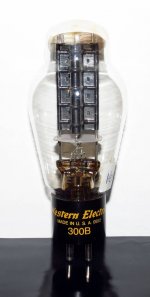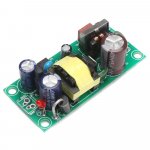6.3VAC Filament winding -> FW bridge -> C -> R -> C
Over 1A filament current requires two large C's. See an example here:
WE 300B Single Ended Amplifier D.I.Y
Over 1A filament current requires two large C's. See an example here:
WE 300B Single Ended Amplifier D.I.Y
Last edited:
6.3V winding feeding a 1N5820 diode bridge feeding a hammond 155B feeding a 10,000uF/25V capacitor.
The choke input supply nudges the voltage down conveniently while also reducing the strain on the power transformer winding.
The choke input supply nudges the voltage down conveniently while also reducing the strain on the power transformer winding.
Is there some C L C circuit for rectifier the 5V filament ?
Just sub the inductor for the R in post #2. The DCR must be similar.
Is there some C L C circuit for rectifier the 5V filament ?
https://www.electra-print.com/images/300bdrdpower.jpg
As Audio Note made for KIT 1, LM7805T. fixed on chassis with isolation kit
Works for years without any type of problem
No noise
Walter
Works for years without any type of problem
No noise
Walter
As Audio Note made for KIT 1, LM7805T. fixed on chassis with isolation kit
Works for years without any type of problem
No noise
Walter
The LM7805T would work alone with the filament ?
The Electra-Print DRD is introducing a winding voltage that will pretty much require a separate power transformer (very few come with a 7V winding) and dumping a bunch of that with a resistive input.
The 7805 works fine but you need to ensure that you have 2V of compliance for the regulator, and that would be 2V of compliance when your line voltage is 5-10% low. Then you need to figure out what the compliance is when your line voltage is 5-10% high, then run the thermal calculations to see how big of a heatsink you need. That's a reasonably large heatsink. You're also back to needing a winding that's more than 6.3V. This might be workable on the 5V/3A rectifier winding if you use a voltage doubler and drop some voltage with an RC filter.
The 7805 works fine but you need to ensure that you have 2V of compliance for the regulator, and that would be 2V of compliance when your line voltage is 5-10% low. Then you need to figure out what the compliance is when your line voltage is 5-10% high, then run the thermal calculations to see how big of a heatsink you need. That's a reasonably large heatsink. You're also back to needing a winding that's more than 6.3V. This might be workable on the 5V/3A rectifier winding if you use a voltage doubler and drop some voltage with an RC filter.
I have designed a few valve amps and valve mixers etc.
When ever I have had hum it has never come down to the heaters being AC.
So I say go for 6VAC.....
When ever I have had hum it has never come down to the heaters being AC.
So I say go for 6VAC.....
I have designed a few valve amps and valve mixers etc.
When ever I have had hum it has never come down to the heaters being AC.
So I say go for 6VAC.....
Did they have directly heated triodes in them?
Did they have directly heated triodes in them?
No, didnt know they still made them ?
DHT filaments are a special use case and require more attention than just adding a DC supply - remember that the filaments are actually connected to the the cathode in the 300B so the power supplies directly affect the sound.
If you want to do it right, the simplest way would be to use these modules (one per 300B of course);
Tube filament supply
If you want a more DIY approach I recommend these kits;
Rod Coleman DHT Filament Regulator
I have first hand experience - I run a derivative of the Transcendent 300B SE-OTL amps - thats four 300Bs per channel, single-ended with no output transformer that uses eight of this type of filament supply - ridiulously inefficient but so, so special.
If you want to do it right, the simplest way would be to use these modules (one per 300B of course);
Tube filament supply
If you want a more DIY approach I recommend these kits;
Rod Coleman DHT Filament Regulator
I have first hand experience - I run a derivative of the Transcendent 300B SE-OTL amps - thats four 300Bs per channel, single-ended with no output transformer that uses eight of this type of filament supply - ridiulously inefficient but so, so special.
The thread title is "simplest and easiest", not how expensive and complicated one could make this procedure.DHT filaments are a special use case and require more attention than just adding a DC supply...
The thread title is "simplest and easiest", not how expensive and complicated one could make this procedure.
Sorry, but how does simple and easy imply a cost? What could be simpler than hooking up an assemble PCB module.
Sorry, but how does simple and easy imply a cost? What could be simpler than hooking up an assemble PCB module.
Either one will have to sit down and determine the values to make said module work with a 300B, or the modules will have to be custom ordered.
The diodes, choke, and capacitors are available from a multitude of electronic component distributors.
Either one will have to sit down and determine the values to make said module work with a 300B, or the modules will have to be custom ordered.
The diodes, choke, and capacitors are available from a multitude of electronic component distributors.
The original poster asked for suggestions for simple and easy filament supply solutions, with no mention of a budget constraint. I offered, in good faith, my suggestions, of which I have direct experience, along with other DC solutions for DHT tubes. The original poster is free to follow up on my suggestions if they choose to do so, as are you; no problem if they don't. What's the problem with that?
Both of the suppliers I linked to would take care of configuring the modules to suit the specific requirement.
Beyond that, life is just to short...
- Home
- Amplifiers
- Tubes / Valves
- Simplest or easyest dc filament supply for 300B

